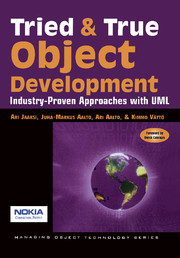Book contents
FOREWORD
Published online by Cambridge University Press: 06 July 2010
Summary
This is a great book about using object technology. Like all the new books in this area, it uses the Unified Modeling Language (UML), which is the standard notation for expressing object-oriented designs. For me, however, Tried & True Object Development really stands out from the recent flood of books on UML. Why? Because, this book is about the realities of object-oriented software engineering written from a position of authority. That authority is based on the authors’ many years of experience developing complex software in Nokia, one of the world's most successful hi-tech corporations. The authors know the secrets of successful object-oriented development from the inside.
However, this book is much more than an experience report, it is truly about how to engineer software. Thus, unlike many other books, it is not written from the perspective of the single engineer working on a small new application. Instead it focuses on how real-world teams, large and small, can use UML and object-oriented methodology. It covers all the phases of software development from requirements through testing. It shows how the fundamental techniques for each of these phases can be molded into an incremental evolutionary lifecycle that can deal with project risk.
Real projects have to handle many problems that lie outside the tidy theories of object-oriented methodologies. This book faces up to those issues. For example, it covers how to make objects persistent using a relational database, and how object-oriented design interfaces with GUI design.
- Type
- Chapter
- Information
- Tried and True Object DevelopmentIndustry-Proven Approaches with UML, pp. xi - xiiPublisher: Cambridge University PressPrint publication year: 1998

